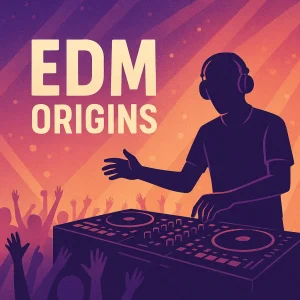What Is EDM? Exploring the Sound and Culture of Electronic Dance Music
Electronic Dance Music, widely known as EDM, refers to a broad range of percussive electronic music genres primarily produced for dance-based entertainment and club environments. Characterized by synthesized beats, bass-heavy drops, repetitive rhythms, and vibrant energy, EDM isn’t just a musical style—it’s a global culture. Rooted in nightlife, underground raves, and experimental sounds, EDM today spans subgenres like house, techno, trance, dubstep, drum and bass, and more. It continues to evolve through digital innovation, music technology, and its strong connection to youth culture, fashion, and social identity. From small underground parties to massive international festivals like Tomorrowland and Ultra, EDM has transformed into a worldwide movement.
The Early Days of Electronic Sound: 1960s–1970s
The roots of EDM trace back to the 1960s and 70s, when pioneers like Kraftwerk, Brian Eno, and Giorgio Moroder experimented with synthesizers, sequencers, and drum machines to create entirely new sounds. These early innovators laid the foundation for electronic music by moving away from traditional instrumentation and embracing technology as a creative tool. In disco clubs, producers began using these electronic instruments to create continuous, beat-driven track. This planted the seeds for the dance music revolution.
House and Techno: The Birthplace of Modern EDM (1980s)
In the 1980s, the true birth of modern EDM occurred in two key cities: Chicago and Detroit. In Chicago, DJs like Frankie Knuckles pioneered house music. It featured four-on-the-floor beats, soulful vocals, and repetitive grooves ideal for club dancing. Meanwhile, in Detroit, producers like Juan Atkins, Derrick May, and Kevin Saunderson created techno. It had a faster, darker, and more mechanical sound. These genres gained traction in underground clubs, particularly within marginalized communities. This therefore laid the blueprint for electronic dance music as we know it today.
The Global Rave Explosion: 1990s
The 1990s saw EDM explode onto the global scene with the rise of rave culture across Europe and North America. Underground warehouse parties, often unregulated and fueled by youth rebellion, became the heartbeat of electronic music. Subgenres like trance, hardcore, and jungle gained popularity, while iconic European acts like The Prodigy, Daft Punk, and Faithless brought EDM to the mainstream spotlight. The use of computers and software in music production also increased, allowing for even greater experimentation and accessibility.
Mainstream Breakthrough: 2000s–2010s
By the early 2000s, EDM was no longer confined to the underground. With artists like David Guetta, Tiesto, Calvin Harris, and Deadmau5, the genre saw a commercial breakthrough. The 2010s cemented EDM’s dominance as a global pop force—thanks to massive festivals (like Tomorrowland, EDC, and Ultra Music Festival), chart-topping hits, and collaborations with mainstream artists like Rihanna, Justin Bieber, and The Chainsmokers. Dubstep, led by artists such as Skrillex, brought bass-heavy, aggressive EDM into the spotlight, while trap EDM emerged as a fusion of hip-hop and electronic sounds.
Digital Production and Social Media: The New Age of EDM
Advancements in digital audio workstations (DAWs) like Ableton Live and FL Studio made it possible for bedroom producers to create professional-grade music without expensive studio equipment. YouTube, SoundCloud, and Spotify gave independent artists platforms to reach global audiences. Social media and live-streamed sets transformed how fans engage with EDM, making it one of the most digitally native music genres of the 21st century.
EDM Today: A Global Culture Beyond the Dancefloor
Today, EDM is more than a genre—it’s a cultural movement. Its influence is visible in fashion, festival experiences, digital art, and youth activism. From Tokyo to Berlin to Nairobi, local EDM scenes blend global sounds with cultural identity. While it continues to thrive in clubs and festivals, EDM is also shaping the future of music through VR concerts, AI-generated beats, and immersive visual performances.
Conclusion: Why EDM Continues to Thrive
EDM’s ability to adapt, innovate, and unite people through rhythm and emotion has kept it at the forefront of global music. Born from the underground and raised in the digital age, it reflects the spirit of modern creativity and community. As technology and culture evolve, electronic dance music is poised to keep pushing boundaries—on the dancefloor and beyond.
